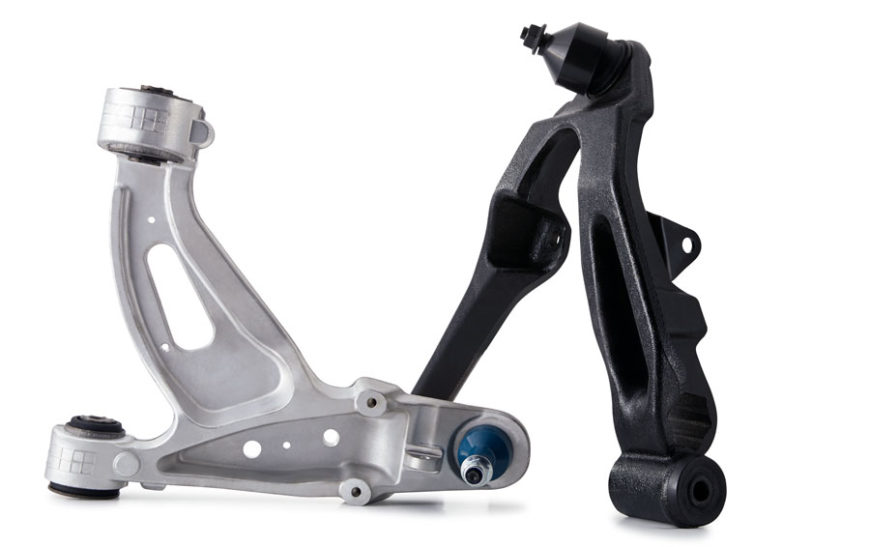When you think of a car, you might envision its sleek exterior, the roar of its engine, or perhaps the comfort of its interior. But hidden beneath the surface lies a symphony of components that work in harmony to create a seamless driving experience. Among these unsung heroes is the control arm, a pivotal element in the automobile’s suspension system. Much like the arms of a conductor guiding an orchestra, control arms play a crucial role in maintaining the vehicle’s stability and handling.
Control arms, often referred to as A-arms due to their distinctive shape, are dynamic links that connect the vehicle’s chassis to its wheels. They facilitate the up-and-down movement of the suspension while ensuring that the tires remain in contact with the road. This connection is essential for providing a smooth ride and maintaining traction, making control arms indispensable to the driving experience.
To truly grasp the importance of control arms, we must first delve into the mechanics of suspension. The suspension system in a vehicle is akin to a finely-tuned music ensemble, where various components collaborate to absorb shocks, facilitate turns, and provide comfort. The control arm, in this case, is not merely a supporting cast member but a leading performer, critical to the overall functionality of the suspension.
Control arms function primarily in two forms: upper and lower. Typically, vehicles will have both types, with the upper control arm situated above the wheel and the lower control arm positioned below it. Together, they work to stabilize the wheel’s movement, allowing it to pivot smoothly as the car navigates varying terrains. The interplay of these arms maintains proper wheel alignment, affecting everything from steering precision to tire wear.
Imagine the control arm as the backbone of a dancer, providing the necessary framework to execute graceful movements. When driving over potholes or navigating sharp turns, the suspension system, led by the control arms, absorbs these shocks, ensuring the driver and passengers remain undisturbed. A failing control arm can result in a cacophony of problems, leading to poor handling, increased tire wear, and an overall decline in safety.
As the miles accumulate, science is revealed: control arms can exhibit wear and tear, much like the muscles of a dancer after hours of practice. Components such as bushings and ball joints—integral parts of the control arm assembly—also contribute to its efficient operation. Bushings act as shock absorbers, reducing vibrations and enhancing comfort, while ball joints serve as pivotal points that allow for free movement. Over time, these elements can degrade, leading to misalignment and undesirable noises that may signal impending failure.
Recognizing the symptoms of a damaged control arm can be incredibly important for vehicle maintenance. A clanking or banging noise when hitting bumps can indicate that the control arm or its associated components are worn out. Other telltale signs might include uneven tire wear or a noticeable change in steering responsiveness—each a subtle invitation to inspect the vehicle more closely.
Regular inspections are essential to ensure the health of control arms. Mechanics may perform a series of tests, such as visual checks for cracks and corrosion or more intricate diagnostic assessments that involve lifting the vehicle and manipulating the suspension. These practices can help catch potential issues before they escalate into costly repairs. Like a diligent maestro ensuring each instrument in the orchestra is harmonic, drivers must stay attuned to the signs their vehicle presents.
The choice of materials used in the construction of control arms also reflects advancements in automotive engineering. Traditionally made from steel, many modern vehicles now incorporate aluminum, which offers a reduced weight while maintaining strength. This shift not only contributes to fuel efficiency but also enhances the longevity of the suspension system. The focus on these innovative materials embodies the automotive industry’s perpetual quest for improvement, mirroring the evolution of dance techniques that refine performance over time.
Furthermore, with the rise of electric vehicles and sophisticated driving technologies, the role of control arms has begun to evolve. New suspension designs are emerging, integrating features such as adaptive and active suspension systems that rely on control arm performance to optimize handling and ride comfort. This evolution signifies a bright future for control arms, as they adapt to the burgeoning needs of modern automobiles.
In conclusion, control arms might not command the same recognition as more prominent automobile components, yet they are an essential part of the vehicular experience. Far from being mere mechanical links, they embody a critical balance of design, functionality, and engineering prowess. From traversing rugged landscapes to gliding along smooth highways, control arms facilitate every drive, presenting a true testament to the craftsmanship behind modern automobiles.
Next time you buckle up for a journey, take a moment to appreciate the complexity and resilience of the control arms working tirelessly beneath you. They may be hidden from view, but their impact on your driving experience is profound, much like the delicate interplay of every note in a symphony that, when executed harmoniously, creates a breathtaking performance.
